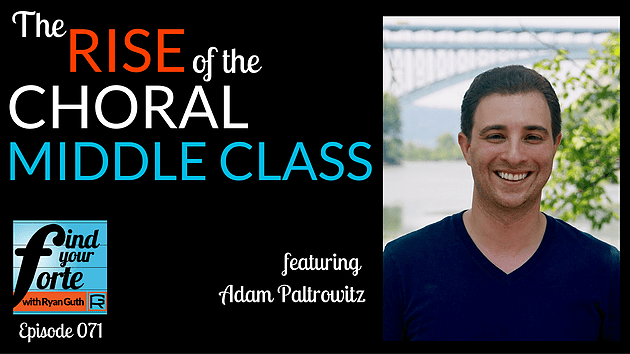What is a self-selected choir?
Try SIGHT READING FACTORY and save 10% using code: choralclarity
Here are 12 differences between a Self-Selected Choir and a Non-Auditioned/Y’All Come Choir:
1. A self-selected choir CAN hold auditions
The director should fully understand each singer’s range, tessitura, tone quality, level of technique, aural training skills, and sight-singing ability. The audition, if you will, should serve as an entry point. You can audition each singer upon enrollment or each after the first few rehearsals. The audition is for placement, not for acceptance into the ensemble. All singers must sing by themselves in their audition.
Additionally, an audition gives each singer the opportunity to learn about their current level of development and how they will benefit moving forward.
How to Voice Your Choir Quickly & Effectively
2. A self-selected choir expects all students to be willing to sing by themselves regularly
There are expectations for each individual singer to develop. There can and should be vocal requirements: all singers must be willing to regularly sing by themselves: this does not have to occur in front of the entire choir. Singers should be willing to sing one-on-one with us, submit Flip or home videos, and be willing to sing alone in a small group setting.
3. A self-selected choir instills individual growth
Students can grow through differentiated instruction and rise to become musical leaders. If a self-selected choir has four grades worth of singers, there should be a path for growth within the choir for 4 years.
I’ve been told from time to time by students that at their annual scheduling appointment with their guidance counselor, they are questioned why they wish to repeat the same class over and over again. Sometimes, non-music teachers view a choir like a chemistry class; you take it once, so there is no point in repeating.
In a well-run self-selected choir, students have a completely different experience every year with more and more opportunities for musical growth. For more information, check out my blog post: Choir: The 4-Year Learning Plan & The Differentiated Learning Myth.
4. A self-selected choir sets clear academic expectations for it’s members
Students must make a commitment to their ensemble. We should also be holding them accountable for what they produce. This may include weekly sight-singing assignments. I recommend using Sight Reading Factory’s student subscriptions for homework (10% discount with code: choralclarity). I also recommend aural training development, and note and rhythm labeling, etc.
We must set up assignments for all students to be successful. In order to accomplish this, we can approach assignments three different ways. Here are a few types:
First, you can give tiered levels of assignments based on level of experience or skill An example would be assigning sight-singing levels (level 1 for 9th graders, level 2 for 10th graders) where singers can “place” into a higher level.
Next, you can give assignments that evaluate growth rather than result. An example would be giving sight-singing homework where students can earn a perfect score if they complete a certain number of attempts.
Finally, you can give baseline assignments where the expectation is that all students can earn a high grade. These tasks are task-oriented rather than talent-based. Two examples would be a note-labeling quiz or lyric memorization fill-in-the-blank extractor quiz.
5. A self-selected choir rehearses like a select ensemble
In a self-selected ensemble, most singers sing with proper body alignment, make markings in their music, and are highly engaged and focused during every rehearsal. An observer of a self-select ensemble would think they were watching a select ensemble because they would immediately recognize pride, discipline, hard work, and a positive learning environment.
This has to do with the singer’s desire to rehearse well rather than the director’s “control” over the group. Self-assessment is a key element to this.
Our Self-Selected Mixed Choir Singing Leonardo Dreams of His Flying Machine
6. A self-selected choir has the TOP SINGERS in it
Usually a non-auditioned or y’all come choir is mainly comprised of “the rest” of the singers while “the best” singers are separated into a select ensemble. On the contrary, a self-selected ensemble includes everyone and therefore has great section leaders and musical role models for all singers. The top singers MUST be in the self-selected choir.
7. A self-selected choir has ALL singers in it (that meet the specified criteria)
Strong, average, and beginning singers sing together in this ensemble. As mentioned in the description of a self-selected ensemble, we can form an ensemble based on age or voice-part, but not based on ability. For example, a school can have a treble choir that consists of all 9th-10th grade sopranos and altos. In this scenario if you are a soprano or alto in 9th or 10th grade, this would be the only ensemble you can join. No singer is pulled out to be in the 11th-12th grade ensemble.
Another example would be having a freshmen-only choir. If all freshmen singers are in this ensemble, it would be a self-selected ensemble. The moment several freshmen are bumped into a different choir to fill the need of another group, this group is no longer a self-selected ensemble.
It is now a partial dumping ground where students are extracted for the gain of others; this would make that ensemble a non-auditioned group because anyone can join but some top singers have a better opportunity elsewhere, therefore diluted this group.
8. A self-selected choir’s repertoire is aimed at the top singers
The top singers in a choral program become the anchors of a self-selected choir. By choosing repertoire that first engages the top singers, they will always remain challenged. Once these singers have learned their part, they will secure the part for the average singers in their section. Additionally, choral rehearsal tracks can be an aid to all singers.
Professional choral rehearsal tracks such as the ones provided by Kinnison Choral Co. (10% discount with code: ChoralClarity21) will allow for layered learning as each singer can learn from varied types of rehearsal tracks (voice-part only, voice-part in one ear while all parts are in the other ear, all voice-parts except for one muted part, full-balanced demo, etc). I believe Kinnison Choral Co. has the highest quality tracks on the market and can engage all singers where they are.
9. A self-selected choir teaches all singers to self-select what they should and shouldn’t be singing
Singers self-select to be in the ensemble but they also must learn to understand they can most effectively contribute musically. We should not expected choir members to sing 100% of the notes and rhythms; instead, they are expected to properly assess what they sing correctly and what they cannot successfully sing (due to limited range, tricky rhythm, difficult leaps, changes in register, etc).
From there, they should mark off sections in the music they cannot accurately sing. As average singers develop, they will be capable of singing a greater percentage of the music. This approach leads singers to gain confidence in what they are successfully singing, and keeps them in their most comfortable range. As their range, technique, and aural skills improve, their tessitura and flexibility will improve, allowing them to sing more and more of the music as they progress through the program.
Our 9th-10th Grade Self-Selected Treble Choir performs “Ergen Deda” by Petar Liondev
10. A self-selected choir can and should sound like a select ensemble
If every member of the ensemble only sings what they can accurately produce, every note and rhythm should be correct. So, for example, in an ensemble of 60 singers, it’s possible that on a difficult passage, only 35 singers will be singing specific notes and rhythms.
The members who we would have chosen for a select ensemble along with some additional average members who have challenged themselves would likely be the ones singing the more difficult passages. These passages will still sound full because those core members make up the largest core of sound.
Our Self-Selected Mixed Choir performs “Jenny” by Nick Myers & Ryan Kerr
11. A self-selected choir has fantastic student leadership
Since a self-selected choir has students of varying vocal ability levels, there are bound to be strong leaders who may not be the strongest singers. These students would typically have been rejected from a select ensemble and would have quit the non-auditioned group because there lacked long-term opportunity.
In a self-selected choir, these students will be motivated to improve, knowing they can remain in the program for their entire high school career. They will become non-musical role models for their peers and become public relations secretary, recording secretary, or even rise to be the top leader of the choir. Our strongest singers will inspire others with their fine music making while the role players will want to create amazing opportunities for their peers.
12. A self-selected group has ownership and tradition
When sport teams are winning, it’s usually because there’s a winning culture. One never knows if winning creates the culture or if the culture creates the winning. When it comes to a select choir, there is usually pride because there is success and everyone is talented. In a non-auditioned choir, there usually lacks ownership because there are no winners; we have removed the winners.
A self-selected choir has top singers who know how to win and has the top leaders who win in other facets of their life. As these students grow within the program for their entire high school career, they will have followed previous students who had served as their role models. Within this framework, we are able to pass down both musical and social traditions. This is how we can build an alumni base and how students enter the program already knowing what to expect.
Last words:
A self-selected program can offer an amazing musical experience for all singers. At the same time, we can challenge, engage, and inspire singers of all levels. For more videos of my self-selected choral program, click here.













Leave A Comment